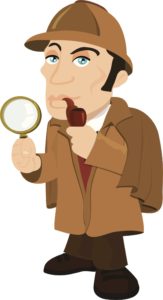Who isn’t familiar with the name Sherlock Holmes?
Thanks to numerous stories, as well as movie and TV adaptions. Sherlock Holmes has the distinction of still being the most famous fictional detective in history.
On Tuesday May 22, we celebrate the detective, which is appropriate because that date also marks the birthday of the man who created him, Sir Arthur Conan Doyle.
I love detective stories. I love following the clues and trying to work out “who dunnit?” Sherlock Holmes was a Master at observation. Nothing, no matter how small the clue, escaped his scrutiny. A Master  Reflexologist requires the same exact skill. That’s why I love “Reading the Feet” – it provides a simple system or road map to read the foot clues! (see below for special offer PS!) The reflex sensitivities in the feet, of a client’s body is actually laying a trail of breadcrumb clues as to what is actively happening in the body. By following these clues absolutely, the body can show first cause of dis-ease and therefore illustrate a path to healing and better health.
Reflexologist requires the same exact skill. That’s why I love “Reading the Feet” – it provides a simple system or road map to read the foot clues! (see below for special offer PS!) The reflex sensitivities in the feet, of a client’s body is actually laying a trail of breadcrumb clues as to what is actively happening in the body. By following these clues absolutely, the body can show first cause of dis-ease and therefore illustrate a path to healing and better health.
Reflexology is a science – artfully applied. Which to me means, using your intuition, solid education and detective skills to identify the sequence of events that co-created the current dis-ease in the body, which in turn will allow you to uncover “who dunnit” – which is the gateway to better health.
So dust off your magnifying glass and deerstalker hat and begin your investigations!
Here are 5 interesting tidbits about the greatest detective who never lived, Sherlock Holmes.
 Sherlock Wasn’t Always Sherlock
Sherlock Wasn’t Always Sherlock
When Sir Arthur Conan Doyle dreamed up his detective, his name was originally “Sherrinford.” Eventually, though, Doyle changed the name to “Sherlock,” which was also the name of a famous cricket player (Doyle was a huge fan of cricket and even played himself).
Dr. Watson Wasn’t Always Dr. Watson
When Doyle came up with the idea of Sherlock’s assistant, Watson, his name was actually Ormond Sacker, which appears in early drafts of the stories.
In The Novels, Sherlock Never Wore That Famous Cap
The cap we most associate with Sherlock is the deerstalker, but in Doyle’s works, he never wears it. The image of the detective in the famous cap actually came from illustrations that appeared with the short stories in Strand magazine in the late 1800s. Artist Sidney Paget drew Sherlock in the cap and those illustrations stayed in the minds of readers: to this day, that’s how fans envision the character.
The First Sherlock Holmes Novel Flopped
Doyle’s first novel about Sherlock was A Study in Scarlet, written in 1887. That novel got rejected by many publishers, although it eventually appeared in Beeton’s Christmas Annual, which still didn’t sell well.
Sherlock Never Said, “Elementary, My Dear Watson” In Doyle’s Stories
Although it’s the most quoted line attributed to the detective, Sherlock never actually said it. He did say, “Elementary” several times and “My dear Watson” at other times, but the full phrase never actually appeared until 1915 when P.G. Wodehouse wrote Psmith, Journalist.
